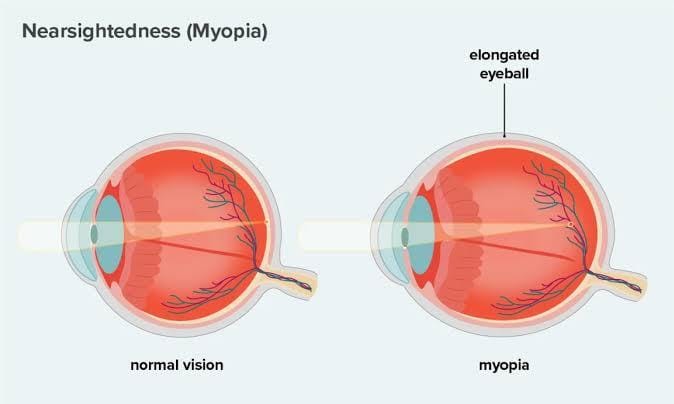50% Of Indians Will Get This Disease! |The Next Pandemic

When people have Myopia or Hyperopia, the shape of their eyeball changes. The eyeball with Myopia is elongated. Because, of this, the focal point is not on the Retina but it is formed before the Retina. And the second case, if you can’t see close to you, it means that you have Hyperopia also known as hypermetropia.
The theory is Near-Work Theory. Some scientists have said that the more time we spend looking at things near us, the more will be the strain on our eyes. This is the near Work Theory. The more time your spend reading books, looking at the screen of your phone or laptop the higher strain.
The DNA theory. Scientists believed that there was no reason behind Myopia, rather, it was said to be related to genetics. Your DNA would decide whether you will have Myopia or not and it would be hereditary. If your family has a history of Myopia, if everyone has glasses, then you will have glasses too. This DNA theory started failing by the 1970s because in 1969, an interesting study was conducted, on Alaskan tribes. It was found that the middle-aged and elderly people of Alaska were never exposed to Myopia.
But in children and teenagers, the rates of Myopia were more than 50%. Such a major change within a single generation, genetics could not be the reason behind it. Especially when it was found that the children were adopting a westernised lifestyle. This is where the Near Work Theory was born.
Although this Near Work theory was not a big discovery in itself. Technically, this theory was more than 400 years old when a German astronomer named Johannes Kepler suggested this for the first time in 1604 that it could be the reason behind neeeding glasses.
Disease Of Affluence
A disease that is more common in rich countries as compared to poor countries. With economic growth, children start studying more, people start working on computers more, people spend less time outdoors, causing widespread instances of Myopia.
Several studies were conducted on animals to find out what actually happens inside the eyes. When we spend time outside, it was found that when we get exposure to bright light, exposure to sunlight, the dopamine production in our retina increases. Dopamine regulates the growth of our eyes. So that our eyes don’t elongate too much. But if there is a lack of dopamine, eyes start elongating. Eyes don’t know when they need to stop growing.
Human trials were conducted to prove this theory. One of the biggest ones was conducted in a collage in Taiwan, which was published in 2020. Thousands of primary schools kids in Taiwan were observed between 2001 and 2015. In 2010, a big change was seen in Taiwan, when their government started a program,
Tian-Tian Outdoor 120. Under this program, schools were told to ensure that students spend at least 2 hours outdoors. And after a few years of the implementation of this program, there was a big positive impact. In 2012, the rates of Myopia in Taiwan was 49.4% among these children. And by 2015, the rate had fallen to 46.1%. This is, just by spending 2 hours outside every day, the need for glasses for kids discreased.
LUX
The brightness of 10,000 lux is considered a good benchmark. Lux is a unit of illuminance. The detectable brightness of an area is measured in lux. If you go out on a sunny day, even if you sit in the shade, your eyes can get exposed to 10,000 lux of brightness quite easily. In tropical countries that get direct sunlight, you can easily reach 100,000 lux brightness.
But if you live indoors, even if you have opened all the windows and doors, if you are sitting inside the house, inside any building, then you can’t even reach 1,000 lux brightness. So it is better to simply go outside. And if you are one of those people who do want to go out, but can’t take out time with all your studying or work, I would say, opt for my Time management Course. Myopia is not a joke.
The latest scientific studies have found that there is a significant correlation between Myopia and blindness. A study published in Investigative Ophthalmology and Visual Science Journal in November 2020 predicted that by 2050, 10% of the word’s population will have High-Grade Myopia. High-grade Myopia means if your glasses prescription is -6 or lower, the more severe your power is, the more elongated your eyes are. Having High-grade Myopia means that in future, your risk of being blind increases.
This is because the retina of the eye is in a finite amount. But if the eye keeps on growing and elongating, then it will be like, you applying butter on a slice of bread, the amount of butter remains the same, So you have to spread the butter more thinly on the bread. The retina also has to keep thinning to spread more over the area of the eye.
